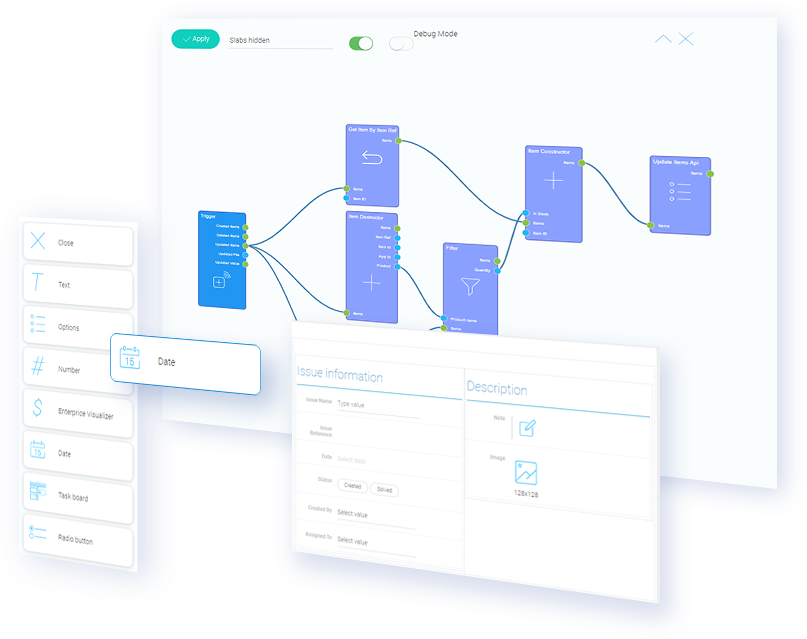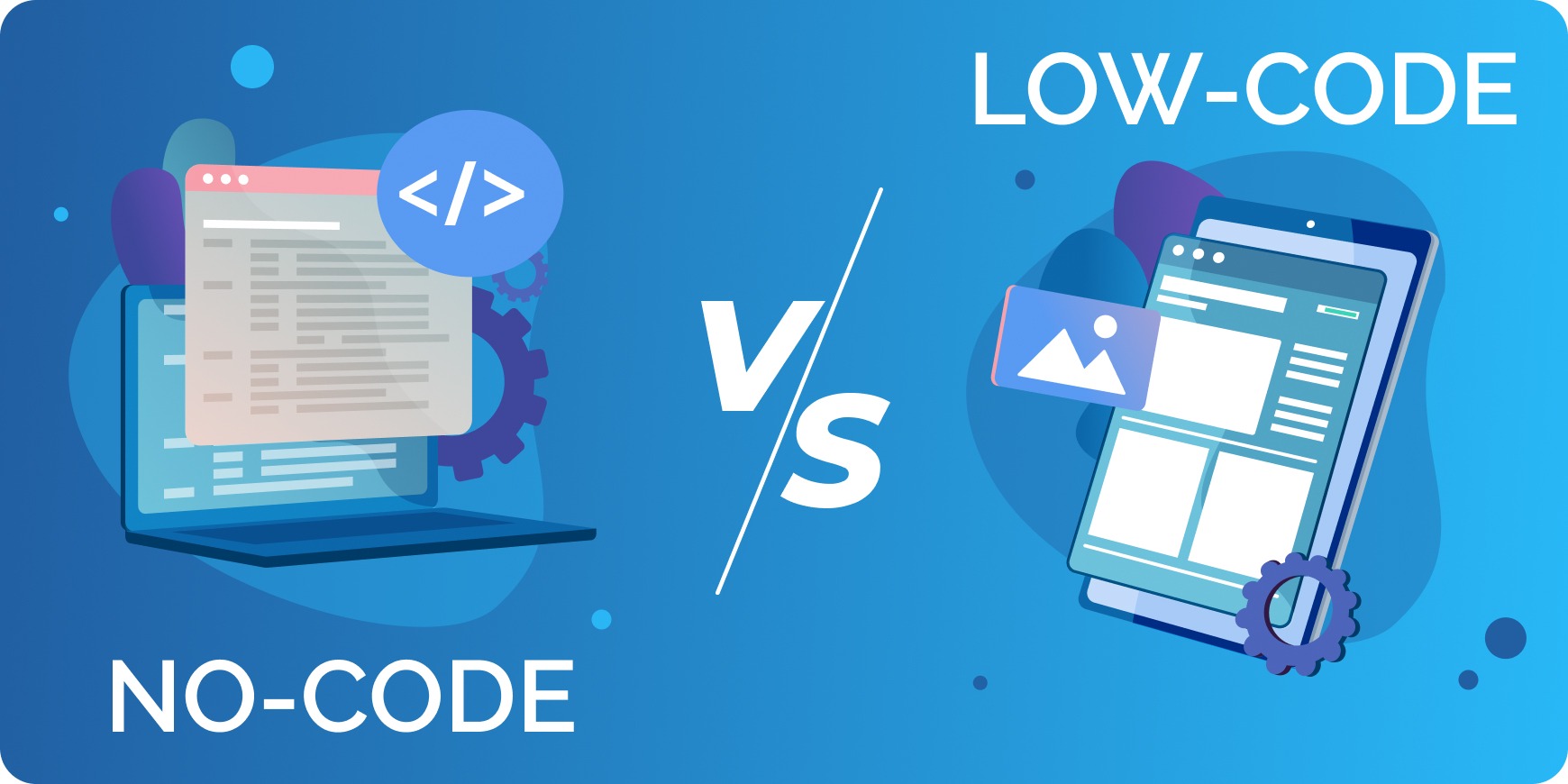Low-Code vs No-Code: which one is better?
Intro to Low-code and No-code
In recent years, the concepts of No-Code and Low-Code have become one of the most trending in the technology market, along with artificial intelligence, VR / AR, blockchain, and data science. A huge amount of money is invested in this area, and the number of startups that develop platforms for working with No Code is increasing almost daily. These days, the possibility that you have used tools with low or no code is very high. Even if you didn't know it yourself. And if you are doing web development, then the likelihood that you have already worked with such tools increases. You can ask: “Is coding still hard?”. The new approach is becoming more popular as a faster and easier alternative to traditional software development. Both professional developers and analysts or business users choose low-code / no-code technologies to create systems and applications of varying complexity to meet the company's needs for modern IT solutions and business automation.
What is No-code?
Commence with defining "What does no code mean?". No-code tools allow ordinary PC users to create websites and applications without the need to write programming code. Instead, the product is assembled as a constructor from existing tools. This helps not only to create a project much faster but also to reduce development costs by 3-4 times compared to conventional code. Until the time when such tools developed quite well and became widespread enough, developing a simple web application was a task that only programmers could solve. Fortunately, this is no longer the case these days.
Is it hard to code? Yes. That is why No-code solutions (or, in other words, codeless app builder) can make it easier to modify or update some existing applications by adding or removing blocks as needed. At the same time, a person must be sure that the new modules will correctly integrate with the existing ones.
Even though no-code app builder is not able to solve all the tasks of developing software projects, the selection and use of such tools will undoubtedly simplify and speed up the solution of some tasks, making more accessible what was previously from, for various reasons, refused. Traditional programming in no-code-tools is not going anywhere. After all, these tools are created by no code developers, who, in the same way, write ordinary code. But, in any case, for end-users of such tools (for most organizations), their use is cheaper and easier than using traditional application development tools. For example, software company EasyStoneShop uses GudHub for its business process.
The work does not look like writing program texts, but like dragging and dropping certain elements with the mouse and working with graphical controls. As we said, this product is aimed at people with little or no programming experience. People rely on visuals to implement workflows, user interfaces, data modules, and more. For example, a UX designer can use pre-designed and coded modules by dragging and dropping them into a single blockchain to achieve the desired result.
Modern no-coding allows you to create almost anything. And you, even if you do not know about it, have already done a lot with the help of such tools. No code companies give users a variety of options in the platforms, from creating websites to developing applications. Using these tools, you can automate the tasks that you have to solve at work or home, you can organize data, create custom projects, and get paid for it. By the way, can you remember when you created any poll on the Internet? Apps for creating such polls are also no-code tools. Such solutions do not rest on the platform's capabilities but adapt to the needs of the business. The development will still take less time than it could have taken when writing code from scratch.

The GudHub system is fully automated for routine work, and you can create your projects by dragging and dropping functional blocks and combining them into a single logical flow. Each time working with the program, the user is automatically authenticated. You can automatically generate documents by dragging automatic fields to the appropriate place. Also, the program picks up items in a particular application that the user has created before, which allows saving time and avoids any possible miscalculations.
What is Low-code?
In situations where there are not enough No Code tools for some functions, the missing options are added with regular code. This way of creating applications and sites is called Low Code. Low-code is an approach to creating, configuring, and modifying systems and applications that require virtually no coding. Low-code platforms use visual interfaces with simple logic and drag-and-drop functions instead of various programming languages. These intuitive tools enable users with no knowledge of programming or software development processes to create their own applications for a variety of purposes. Such platforms help greatly speed up and simplify development, eliminate the need for some processes, but still require development skills, and sometimes even a whole team of programmers.
Low-code occupies a niche between development without code and full-fledged programming. Although it requires some programming knowledge, Low-code is still much easier and faster than coordinating entire projects from scratch. As with no-code systems, Low-code tools use visuals to build applications, but there are differences in this.
Low-code has almost all the same advantages as no-code tools: speed to market, lower costs, and ease of modification and maintenance, albeit not at the same level. If technologies without code do not offer all the functionality required to create a user interface, then in comparison low-code vs high code, the first one is likely to be a good alternative.
Who can use Low-code?
Perhaps any employee of the company, from HR managers to professional developers, may use low code platforms. The simplicity of these tools and their scalability allows any user to independently create the necessary functionality. Such programs as GudHub have everything you need for such use. For example, it has an open API, so you can easily integrate your web applications or web services with GudHub. It is also integrated with a lot of popular web services, like Slack or Twilio. Here you can store big data (hundreds or thousands of items) in one application and create as many programs as you require.
Should I use Low-code?
Our answer - definitely yes. There are numerous benefits to using a low-code platform. Low-code platforms are great for prototyping. They bridge the gap between business users and IT, which allows you to quickly get a working prototype and form a vision for the future system. In addition, the use of graph databases through Low-Code allows you to make changes to business processes without stopping work or blocking access.
In Low-code systems, a simple and functional interface is most often implemented for the convenience of the user. At the same time, the systems themselves are filled with ready-made templates for various business processes that are used in other companies, including industry leaders. The business can directly take these processes and adapt to their own activities and stacks, and computing systems without programming and data visualization technologies simplify the analyst's work and reduce the need to attract developers.
With Low code, you can speed up your business process automation. Most low-code platforms, such as GudHub, include a business process management engine (BPM), which allows you to automate processes faster and manage them more efficiently. Such platforms are easier to use and develop compared to most classic BPM platforms, which are difficult to use.
To give you the best answer to this question, we have prepared for you the list of 7 reasons to use the low-code platforms:
- Reducing the time from idea to implementationAs a result, as the speed of business transformation grows, IT teams are getting an excellent working tool for increasing productivity and shortening the software development cycle.
- Cost reductionLow-code does not require deep knowledge and development experience, which helps to solve the problem of lack of IT specialists that many companies face. Easy-to-use tools allow analysts or business users to customize applications with minimal involvement of IT experts - and this reduces the cost of expensive company resources.
- Improving customer experienceCustomers are more demanding today than ever. Low-code platforms give you the flexibility to easily adapt to market changes and customer needs by quickly implementing modern IT solutions or continuously updating existing software per current trends.
- High level of securityModern platforms are very demanding to protect programs and the information stored in them from various violations, therefore, they contain the necessary tools for administration, access control, and threat assessment. This makes it easy to configure and monitor the security of the system.
- Control over IT infrastructure
- Business and IT cooperationLow-code platforms provide an opportunity to establish a close connection between business and IT- thanks to ready-made functional modules, an understandable user interface, and powerful tools for professional developers, they allow literally everyone in the company, to speak the same language and create applications of any complexity in the same environment.
- Accelerating digital transformationCompanies are forced to automate more and more processes to keep up with the times and be competitive. Low-code platforms provide organizations with fundamental technologies that help accelerate the transformation cycle, adapt, and innovate faster.
What can be created with low-code technologies?
- With drag-and-drop visual designers, low-code platforms help users create and customize applications to solve a variety of business problems: from automating client processes and organizing teamwork to data management and integration with third-party systems.
- Customer service systems. Customize your unique CRM solutions to improve sales efficiency, improve lead conversion, automate marketing tasks, personalize customer communications and improve service quality.
- Tools to improve operational efficiency. Build apps to improve employee productivity and eliminate routine. Automation provides you with a range of benefits, including cost savings and reduced error rates.
- Business processes. Describe and automate business processes of any complexity to improve their performance. Set up cross-departmental end-to-end or iterative processes to speed them up.
- Interface, data models, and business logic. Use simple tools to customize the data structure, user interface, and application logic for both the browser and mobile devices.
- Al-based solutions. Connect machine learning algorithms and other AI technologies to accelerate data processing, minimize manual steps and improve decision-making.
Difference between Low-code and No-code
The concepts of low-code and no-code are similar, which is why they are often referred to together. Both platforms use visual interfaces so that users can develop their own IT solutions without having deep technical knowledge or programming experience.
The main difference between low code and no-code platforms (and this follows from their names) is that the former in some cases require writing program code, while the latter do without programming at all.
This means that no-code technologies are targeted at non-developers (for example, system analysts or business users). At the same time, low-code platforms can be used by both users and professional developers, which makes them able to create larger and more complex applications. For greater flexibility and control over the software development cycle, forward-thinking enterprises are deploying platforms that combine both technologies.
Besides, if Low-Code you can quickly modify, improve and expand work with business processes and analytics, then with the help of No Code is more about web development and creating your own services from ready-made templates. By simply dragging and dropping elements, with almost no technical knowledge, you can create a complete working product - say, a website or a mobile application.Example of text inside paragraph
Let's understand in more detail the difference between these two terms.
Pros of Low - code and No - code
Low - code Pros | No - code Pros |
Independent platform | Fast development |
Speed | Reduced cost |
Low development cost | Increased productivity |
Efficiency | Easy to fix and changeExample of text inside paragraph |
Ability to create business solutions with low programming skills |
Cons of Low - code and No - code
| Low - code Cons | No - code Cons |
| Limited scalability | Rigid templatesRigid templates |
| Customization | Lack of property rights |
| Long-term costs | Security and Compliance Issues |
| Programming knowledge required | Limited flexibility |
| Limited observability / monitoring | |
| Cell |
One of these solutions is GudHub - a Low-Code development platform. It is also may be used as No code. This platform has a very convenient and intuitive user interface, making it easy and simple to create web applications without resorting to traditional programming.

Is Low-code No-code the future?
Low-code and no-code development platforms promise to help both professional and non-professional developers build applications more efficiently, thereby increasing productivity. Both eliminate the overhead of creating environments and maintaining infrastructure, as it is almost always offered in a platform-as-a-service form factor.
One can be skeptical that it is possible to create a product without using code. The trick is that technologies that help create a product without a code still have this code. It is simply not seen by ordinary users.
It seems that the market for No-Code app development will actively continue to develop further. In addition to increasing the investment attractiveness of this area, more and more people will use the opportunities of these technologies against the background of a gradual decrease in the entry into the field of programming. In the same way that architecture moved from thousands of mock-ups per building project to special architectural programs, in the future, instead of a whole team of developers per application, only a few.
GudHub - Platform for automation of business processes of any complexity
While the GudHub can certainly be used as a no-code platform, it does stand out in the low-code too. The user can easily customize the required sequence of actions, user interfaces, transition conditions, rules for automatic steps, or data processing. Working with filters, reports, templates, the user sees his data conveniently and clearly. Instead of setting up and developing an application from scratch, with the help of GudHub, you can immediately get the finished result, speeding up the adaptation and implementation of the system at times.
Using all the GudHub features, you are also able to edit the template of your application, edit styles of elements, change container sizes, etc. Choose from a big amount of data types that may be added to the application, and you can customize them for your purposes.




